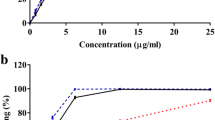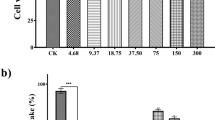Abstract
The dietary intake and control of blood glucose levels are very important in hyperglycemic patients and α-glucosidase inhibitors are a cost-effective means to preventing the progression of diabetes. In search of a natural inhibitor from food materials, α-glucosidase inhibitory activity and the anti-hyperglycemic effects of a brown alga, Ecklonia stolonifera, were investigated using non-insulin dependent diabetic mice. Methanolic extract of E. stolonifera (MEE), which contains a high content of polyphenols, showed strong inhibition of α-glucosidase in vitro. Male KK-Ay mice, a genetically non-insulin dependent diabetic model, showed hyperglycemia with aging, but the ingestion of MEE suppressed the increase in plasma glucose and lipid peroxidation levels in unfasted KK-Ay mice dose dependently. In KK-Ay mice, which were fed the MEE diet for 4 weeks, MEE moderated the elevation of plasma glucose levels after the oral administration of maltose. The polyphenols in MEE were estimated to be phlorotannins by HPLC-PDA and LC/MS analyses. These results demonstrate that E. stolonifera, seaweed typically used as a health food, has strong antidiabetic and antioxidant effects in vivo, thus, it may have beneficial properties in the prevention of diabetes and could be useful in the development of an antidiabetic pharmaceutical and functional food.



Similar content being viewed by others
Abbreviations
- DNJ:
-
1-deoxynojirimycin
- HPLC-PDA:
-
high performance liquid chromatography with photodiode array detection
- LC/MS:
-
liquid chromatography mass spectrometry
- MEE:
-
methanolic extract of E. stolonifera
- TBARS:
-
thiobarbituric acid reactive substance
- WEE:
-
water extract of E. stolonifera
References
Peyrieras N, Bause E, Legler G, Vasilov R, Claesson L, Peterson P, Ploegh H (1983) Effects of the glucosidase inhibitors nojirimycin and deoxynojirimycin on the biosynthesis of membrane and secretory glycoproteins. EMBO J 2:823–832
Yan X, Nagata T, Fan X (1998) Antioxidative activities in some common seaweeds. Plant Foods Hum Nutr 52:1573–9104 doi:10.1023/A:1008007014659
Taniguchi K, Kurata K, Suzuki M (1991) Feeding-deterrent effect of phlorotannins from the brown alga Ecklonia stolonifera against the abalone Haliotis discus hannai. Nippon Suisan Gakkaishi 57:2065–2071
Iwahori Y, Enomoto S, Okada Y, Tanaka J, Okuyama T (1999) Naturally occurring substances for prevention of complications of diabetes. IV. Screening of seavegetables for inhibitory effect on aldose reductase. Nat Med 53:138–140
Kang KA, Lee KH, Chae S, Koh YS, Yoo BS, Kim JH, Ham YM, Baik JS, Lee NH, Hyun JW (2005) Triphlorethol-A from Ecklonia cava protects V79-4 lung fibroblast against hydrogen peroxide indiced cell damage. Free Radic Res 39:883–892 doi:10.1080/10715760500161165
Nagayama K, Iwamura Y, Shibata T, Hirayama I, Nakamura T (2002) Bactericidal activity of phlorotannins from the brown alga Ecklonia kurome. J Antimicrob Chemother 50:889–893 doi:10.1093/jac/dkf222
Shibata T, Fujimoto K, Nagayama K, Yamaguchi K, Nakamura T (2002) Inhibitory activity of brown algal phlorotannins against hyaluronidase. Int J Food Sci Technol 37:703–709 doi:10.1046/j.1365-2621.2002.00603.x
Ohta T, Sasaki S, Oohori T, Yoshikawa S, Kurihara H (2002) α-Glucosidase inhibitory activity of a 70% methanol extract from Ezoishige (Pelvetia babingtonii de Toni) and its effect on the elevation of blood glucose level in rats. Biosci Biotechnol Biochem 66:1552–1554 doi:10.1271/bbb.66.1552
Kang HS, Chung HY, Kim JY, Son BW, Jung HA, Choi JS (2004) Inhibitory phlorotannins from the edible brown alga Ecklonia stolonifera on total reactive oxygen species (ROS) generation. Arch Pharm Res 27:194–198
Kim YC, An RB, Yoon NY, Nam TJ, Choi JS (2005) Hepatoprotective constituents of the edible brown alga Ecklonia stolonifera on tacrine-induced cytotoxicity in Hep G2 cells. Arch Pharm Res 28:1376–1380
Kang HS, Kim HR, Byun DS, Son BW, Nam TJ, Choi JS (2004) Tyrosinase inhibitors isolated from the edible brown alga Ecklonia stolonifera. Arch Pharm Res 27:1226–1232
Gao X, Björk L, Trajkovski V, Uggla M (2000) Evaluation of antioxidant activities of rosehip ethanol extracts in different test systems. J Sci Food Agric 80:2021–2027 doi:10.1002/1097-0010(200011)80:14<2021::AID-JSFA745>3.0.CO;2-2
Kim MY, Iwai K, Onodera A, Matsue H (2003) Identification and antiradical properties of anthocyanins in fruits of Viburnum dilatatum Thunb. J Agric Food Chem 51:6173–6177 doi:10.1021/jf034647p
Reeves PG, Nielsen FH, Fahey GC Jr (1993) AIN-93 purified diets for laboratory rodents: final report of the American Institute of Nutrition ad hoc writing committee on the reformulation of the AIN-76A rodent diet. J Nutr 123:1939–1951
Iwai K, Onodera A, Matsue H (2004) Inhibitory effects of Viburnum dilatatum Thunb. (gamazumi) on oxidation and hyperglycemia in rats with streptozotocin-induced diabetes. J Agric Food Chem 52:1002–1007 doi:10.1021/jf0302557
Iwatsuka H, Shino A, Suzuoki Z (1970) General survey of diabetic features of yellow KK mice. Endocrinol Jpn 17:23–35
Lee KS, Choi YS, Seo JS (2004) Sea tangle supplementation lowers blood glucose and supports antioxidant systems in streptozotocin-induced diabetic rats. J Med Food 7:130–135 doi:10.1089/1096620041223996
Fujiwara T, Shimada M, Yoshioka S, Shiraki T, Horikoshi H (1988) Age-related development and regression of diabetic syndrome. Annu Rep Sankyo Res Lab 40:73–82
Asayama K (1990) Free radicals and diabetes mellitus. Mod Med 45:1736–1742
Ohnishi M, Matuo T, Tsuno T, Hosoda A, Nomura E, Taniguchi H, Sasaki H, Morishita H (2004) Antioxidant activity and hypoglycemic effect of ferulic acid in STZ-induced diabetic mice and KK-Ay mice. Biofactors 21:315–319
Onishi E, Yamada T, Yamada K, Inoue H, Seyama Y, Yamashita S (1986) Comparison of experimental diabetes induced by streptozotocin and cyproheptadine. Folia Pharmacologica Japonica 87:105–112 doi:10.1254/fpj.87.105
Okazaki M, Saito Y, Udaka Y, Maruyama M, Murakami H, Ota S, Kikuchi T, Oguchi K (2002) Diabetic nephropathy in KK and KK-Ay mice. Exp Anim 51:191–196 doi:10.1538/expanim.51.191
Author information
Authors and Affiliations
Corresponding author
Rights and permissions
About this article
Cite this article
Iwai, K. Antidiabetic and Antioxidant Effects of Polyphenols in Brown Alga Ecklonia stolonifera in Genetically Diabetic KK-Ay Mice. Plant Foods Hum Nutr 63, 163–169 (2008). https://doi.org/10.1007/s11130-008-0098-4
Published:
Issue Date:
DOI: https://doi.org/10.1007/s11130-008-0098-4




